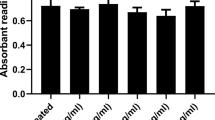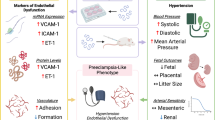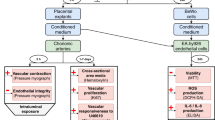Abstract
Pregnancy is a state of vasodilation mediated by nitric oxide (NO). This vasodilation is impaired in women with preeclampsia, and an alteration in the L-arginine–NO pathway may be a causal factor. The production of NO and arginase activity were investigated in plasma and human umbilical vein endothelial cells (HUVECs) from women with preeclampsia, which were associated with arginase II, eNOS, caveolin, angiotensin 1 and 2 receptor expression (AT1R and AT2R, respectively). The effect of (−)-epicatechin on arginase activity and production of anion superoxide in HUVEC also were investigated. Healthy volunteer non-pregnant (HV), normal pregnant (NP) and preeclamptic (PE) women were recruited for this study. Higher values of nitrite/nitrate (NO2/NO3) were detected in the plasma from PE women as opposed to HV and NP. Lower arginase activity in PE versus HV or NP women was observed. HUVECs from PE women showed lower values of NO2/NO3, higher activity of arginase and higher expression of AT1R and AT2R than HUVECS from NP women. Interestingly, arginase activity was associated with AT2R stimulation; indeed this activity and the high NADPH (nicotinamide adenine dinucleotide phosphate) oxidase activity in HUVECs from PE women can uncouple the production or inactivation of NO. However, we demonstrated that (−)-epicatechin could lead to a decrease in the activity of both enzymes.
This is a preview of subscription content, access via your institution
Access options
Subscribe to this journal
Receive 12 digital issues and online access to articles
$119.00 per year
only $9.92 per issue
Buy this article
- Purchase on Springer Link
- Instant access to full article PDF
Prices may be subject to local taxes which are calculated during checkout




Similar content being viewed by others
References
Krause BJ, Hanson MA, Casanello P . Role of nitric oxide in placental vascular development and function. Placenta 2011; 32: 797–805.
Maynard SE, Karumanchi SA . Angiogenic factors and preeclampsia. Semin Nephrol 2011; 31: 33–46.
Pennington KA, Schlitt JM, Jackson DL, Schulz LC, Schust DJ . Preeclampsia: multiple approaches for a multifactorial disease. Dis Model Mech 2012; 5: 9–18.
Teran E, Escudero C, Moya W . Abnormal release of nitric oxide from nitrosoprotein in preeclampsia. Int J Gynaecol Obstet 2006; 92: 260–261.
Bagnost T, Berthelot A, Bouhaddi M, Laurant P, Andre C, Guillaume Y et al. Treatment with the arginase inhibitor N(omega)-hydroxy-nor-L-arginine improves vascular function and lowers blood pressure in adult spontaneously hypertensive rat. J Hypertens 2008; 26: 1110–1118.
Ash DE . Structure and function of arginases. J Nutr 2004; 134: 2760S–2764S discussion 2765S–2767S..
Berkowitz DE, White R, Li D, Minhas KM, Cernetich A, Kim S et al. Arginase reciprocally regulates nitric oxide synthase activity and contributes to endothelial dysfunction in aging blood vessels. Circulation 2003; 108: 2000–2006.
Ryoo S, Gupta G, Benjo A, Lim HK, Camara A, Sikka G et al. Endothelial arginase II: a novel target for the treatment of atherosclerosis. Circ Res 2008; 102: 923–932.
Demougeot C, Prigent-Tessier A, Marie C, Berthelot A . Arginase inhibition reduces endothelial dysfunction and blood pressure rising in spontaneously hypertensive rats. J Hypertens 2005; 23: 971–978.
Noris M, Todeschini M, Cassis P, Pasta F, Cappellini A, Bonazzola S et al. L-arginine depletion in preeclampsia orients nitric oxide synthase toward oxidant species. Hypertension 2004; 43: 614–622.
Sankaralingam S, Xu H, Davidge ST . Arginase contributes to endothelial cell oxidative stress in response to plasma from women with preeclampsia. Cardiovasc Res 2010; 85: 194–203.
Cui XL, Brockman D, Campos B, Myatt L . Expression of NADPH oxidase isoform 1 (Nox1) in human placenta: involvement in preeclampsia. Placenta 2006; 27: 422–431.
Dechend R, Viedt C, Müller DN, Ugele B, Brandes RP, Wallukat G et al. AT1 receptor agonistic antibodies from preeclamptic patients stimulate NADPH oxidase. Circulation 2003; 107: 1632–1639.
Redman CWG, Sargent IL . Pre-eclampsia, the placenta and the maternal systemic inflammatory response-a review. Placenta 2003; 24: S21–S27.
Xia Y, Wen H, Bobst S, Day MC, Kellems RE . Maternal autoantibodies from preeclamptic patients activate angiotensin receptors on human trophoblast cells. J Soc Gynecol Invest 2003; 10: 82–93.
Corraliza IM, Campo ML, Soler G, Modolell M . Determination of arginase activity in macrophages: a micromethod. J Immunol Methods 1994; 174: 231–235.
Jaffe EA (ed).. Culture and identification of large vessel endothelial cells. in Biology of Endothelial Cells, pp 1–13 (Martinus Nijhoff: Boston, 1984).
Alemán I, Alex R, Ramírez M, Hung A, Ramírez C . Endothelial and inducible nitric oxide synthase expression in Venezuelan patients with pre-eclampsia. Invest Clin 2008; 49 (3): 321–330.
Baksu B, Davas I, Baksu A, Akyol A, Gulbaba G . Plasma nitric oxide, endothelin-1 and urinary nitric oxide and cyclic guanosine monophosphate levels in hypertensive pregnant women. Int J Gynaecol Obstet 2005; 90 (2): 112–117.
Teran E, Escudero C, Vivero S, Enriquez A, Calle A . Intraplatelet cyclic guanosine-3′,5′-monophosphate levels during pregnancy and preeclampsia. Hypertens Pregnancy 2004; 23 (3): 303–308.
Romero MJ, Platt DH, Tawfik HE, Labazi M, El-Remessy AB, Bartoli M et al. Diabetes-induced coronary vascular dysfunction involves increased arginase activity. Circ Res 2008; 102: 95–102.
Gao X, Xu X, Belmadani S, Park Y, Tang Z, Feldman AM et al. TNF-alpha contributes to endothelial dysfunction by upregulating arginase in ischemia/reperfusion injury. Arterioscler Thromb Vasc Biol 2007; 27: 1269–1275.
Zhang W, Baban B, Rojas M, Tofigh S, Virmani SK, Patel C et al. Arginase activity mediates retinal inflammation in endotoxin-induced uveitis. Am J Pathol 2009; 175: 891–902.
Sankaralingam S, Xu Y, Sawamura T, Davidge ST . Increased lectin-like oxidized low-density lipoprotein receptor-1 expression in the maternal vasculature of women with preeclampsia: role for peroxynitrite. Hypertension 2009; 53: 270–277.
Matsubara K, Matsubara Y, Hyodo S, Katayama T . Ito M Role of nitric oxide and reactive oxygen species in the pathogenesis of preeclampsia. J Obstet Gynaecol Res 2010; 36 (2): 239–247.
Sharma JB, Sharma A, Bahadur A, Vimala N, Satyam A, Mittal S . Oxidative stress markers and antioxidant levels in normal pregnancy and preeclampsia. Int J Gynaecol Obstet 2006; 94 (1): 23–27.
Myatt L, Cui X . Oxidative stress in the placenta. Histochem Cell Biol 2004; 122 (4): 369–382.
Chen GF, Wagner L, Sasser JM, Zharikov S, Moningka NC, Baylis C . Effects of angiotensin type 1 receptor blockade on arginine and ADMA synthesis and metabolic pathways in fawn-hooded hypertensive rats. Nephrol Dialysis Transplant 2010; 25: 3518–3525.
Mehta PK, Griendling KK . Angiotensin II cell signaling: physiological and pathological effects in the cardiovascular system. Am J Physiol Cell Physiol 2007; 292: C82–C97.
Carey RM . Cardiovascular and renal regulation by the angiotensin type 2 receptor: the AT2 receptor comes of age. Hypertension 2005; 45: 840–844.
Carey RM, Padia SH . Angiotensin AT2 receptors: control of renal sodium excretion and blood pressure. Trends Endocrinol Metab 2008; 19: 84–87.
Akbar SA, Khawaja NP, Brown PR, Tayyeb R, Bamfo J, Nicolaides KH . Angiotensin II type 1 and 2 receptors gene polymorphisms in preeclampsia and normal pregnancy in three different populations. Acta Obstet Gynecol Scand 2009; 23: 1–6.
Shatanawi A, Romero MJ, Iddings JA, Chandra S, Umapathy NS, Verin AD et al. Angiotensin II-induced vascular endothelial dysfunction through RhoA/Rho kinase/p38 mitogen-activated protein kinase/arginase pathway. Am J Physiol Cell Physiol 2011; 300: C1181–C1192.
Acknowledgements
This work was supported by the grants IPN-ESM-SIP 20100270, CONACyT CB-2010–01 157739 and CONACyT CB-2009–01 129–889.
Author information
Authors and Affiliations
Corresponding author
Ethics declarations
Competing interests
The authors declare no conflict of interest.
Additional information
Supplementary Information accompanies the paper on the Journal of Human Hypertension website
Supplementary information
Rights and permissions
About this article
Cite this article
González-Garrido Chem, J., Olivares-Corichi, I., Tovar-Rodriguez, J. et al. Influence of the AT2 receptor on the L-arginine–nitric oxide pathway and effects of (-)-epicatechin on HUVECs from women with preeclampsia. J Hum Hypertens 27, 355–361 (2013). https://doi.org/10.1038/jhh.2012.55
Received:
Revised:
Accepted:
Published:
Issue Date:
DOI: https://doi.org/10.1038/jhh.2012.55
Keywords
This article is cited by
-
The renin-angiotensin system modulates endotoxic postconditioning of exacerbated renal vasoconstriction in preeclamptic offspring
Scientific Reports (2023)
-
Cardiovascular Benefits of Dark Chocolate?
Current Treatment Options in Cardiovascular Medicine (2015)



